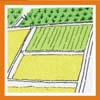From TKWB - Traditional Knowledge World Bank
Jump to navigation
Jump to search
| GENERAL DEFINITION OF THE TECHNIQUE |

|
| Technique: |
CROP ROTATION AND FALLOWING |
|
Definition characters description and diffusion
The process of organizing space in the Mediterranean is carried out thanks to the exploitation of the slopes and the practice of the techniques for fertilizing those inaccessible areas disregarded by the previous colonizers. The iron ploughshare, which had been used since the start of the 1st millennium BC in the Near East, spread over Europe and at the end of the millennium. The use of metal tools determined a more aggressive approach to the environment with the phonomenon of deforestation as well as of the productive exploitation of the marginal areas. In that same period the system of threefields rotation was introduced: cereals, oats, and legumes.
General characters description and diffusion
The practice of crop rotation entails growing different crops in sequence. Crops vary in their nutrient demands, susceptibility to pests and diseases and ability to cope with erosion. A good system of crop rotation facilitates restoriation of the soil structure and fertility, this controls erosion and reduces pests and diseases. Certain weeds such as Striga, can be controlled or limited by crop rotation. On many small-scale farms, cereals are rotated with pulses, root crops and occassionally grass. Grain crops are relayed after two to three years of each, followed by a legume crop such as beans, groundnuts, or sunflower. It has since been tried by virtually all communities practicing crop farming in dry lands. Some Brazilian communities practice rotations between crop and livestock production. From the end of the 1st millennium BC onward, agriculture in the temperate Europe was able to support levels of population and urbanization comparable with those based on irrigation of the hot and sunny areas of the Middle East. There were no other major inventions in the following periods, only the development into more sophisticated systems of already existing techniques and knowledge. The grapevine and the olive tree were grown on the terraced systems by that time. Drainage systems, canals as well as irrigation and reclamation methods allowed the plains to be used for agriculture. The practice of leaving land fallow and manuring the soil made agriculture more productive. The land fallowing system, which was also introduced through early missionary and government intervention, entailed that farmers cultivate the land for three to eight years and allow it to rest for two to four years. This practice is basically akin to shifting cultivation, is low-input and familiar to local communities. But the shortage of agricultural land has tended to work against this technology. It is today an important alternative solution to the artificial fertilizers and guarantees the biologic qualities of the products.
Advantages and sustainability
Land fallowing allows the land to rest for a period of two to four years after having been cultivaled for a period of three to eight years in an attempt to lessen the use of artificial fertilizers needed and in other cases of crop rotation pests and diseases are reduced as well as the fertility of the soil increased.
Images
Deepening
|
TRADITIONAL TECHNIQUE DATA
| Technique |
| CROP ROTATION AND FALLOWING |
| Icon |
 |
| Cathegory |
| B - Agriculture |
| Identification code |
| B9h |
| Author: |
|
| Other authors: |
|
| Reference: |
|
|
|